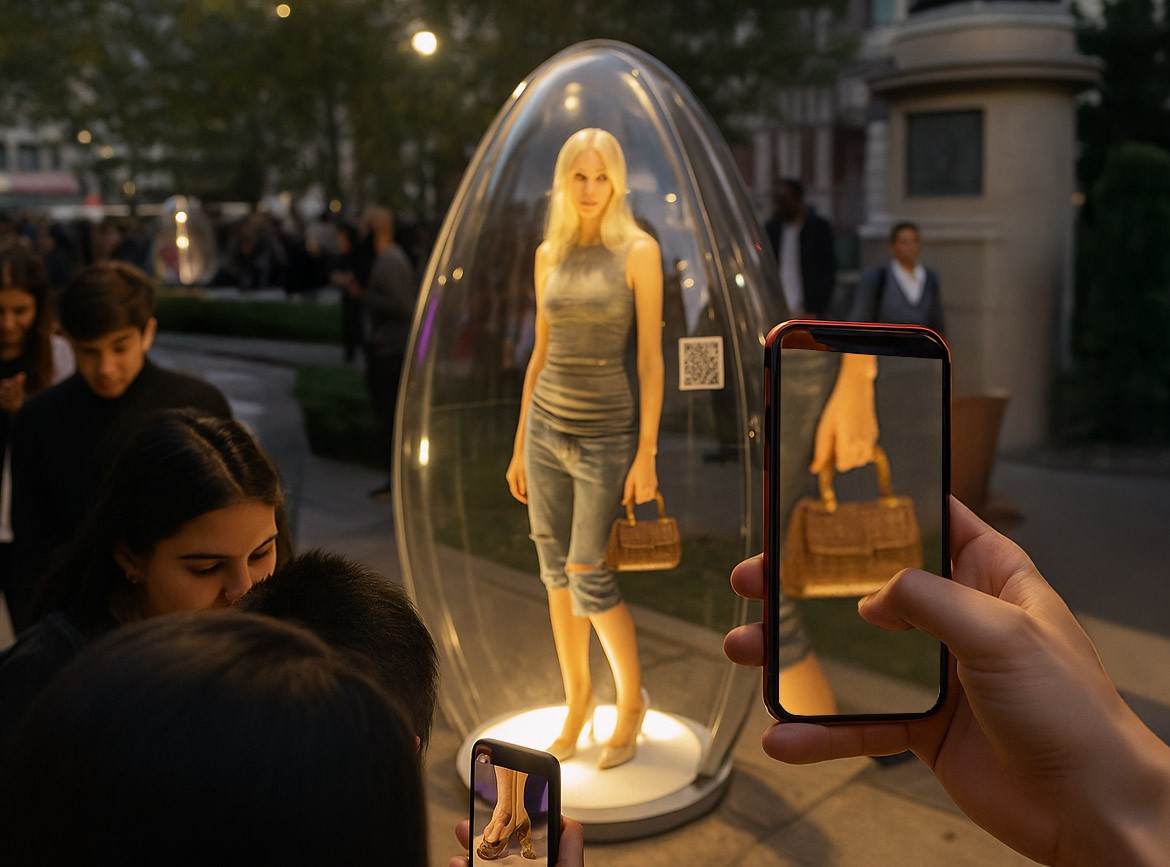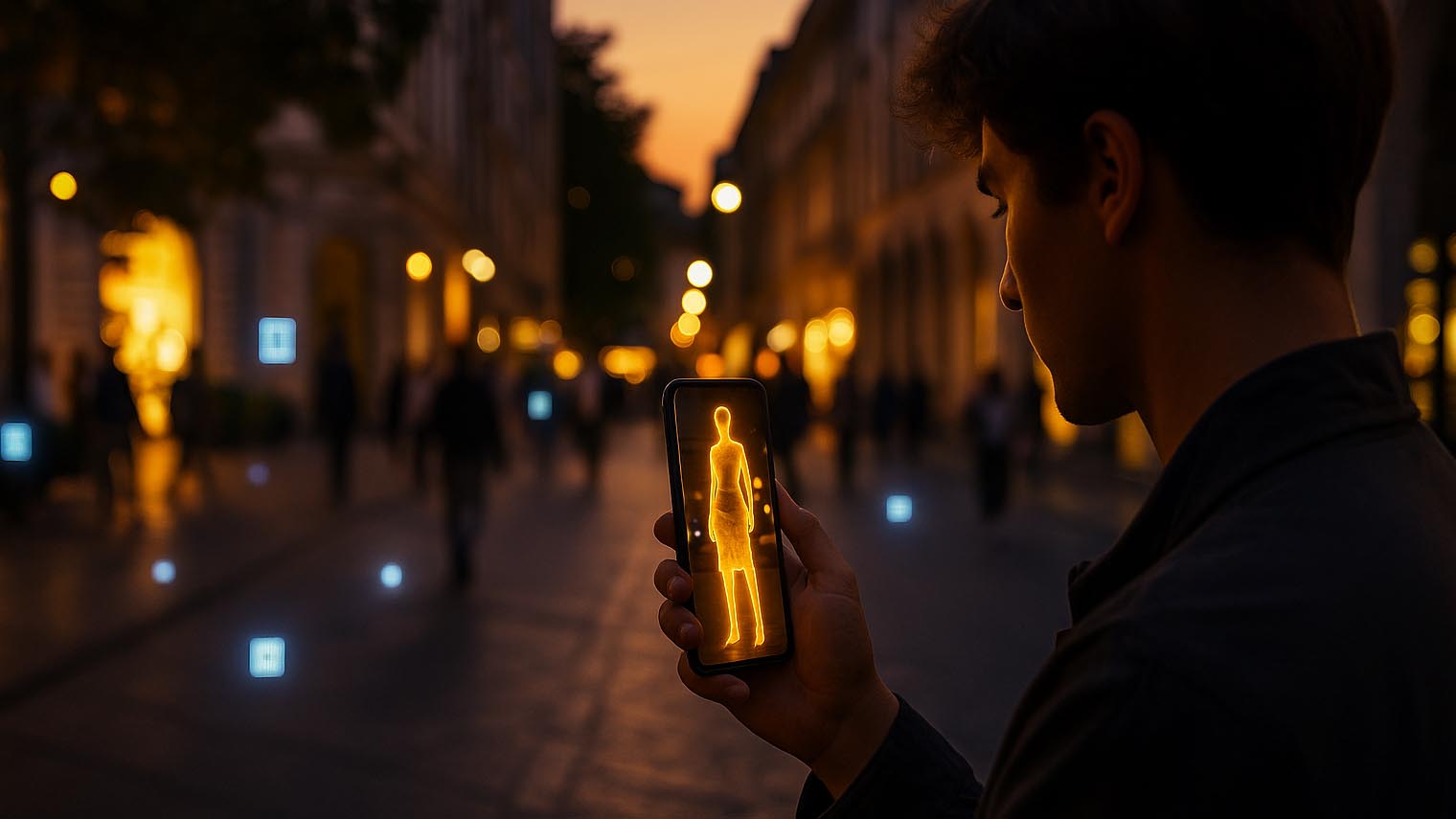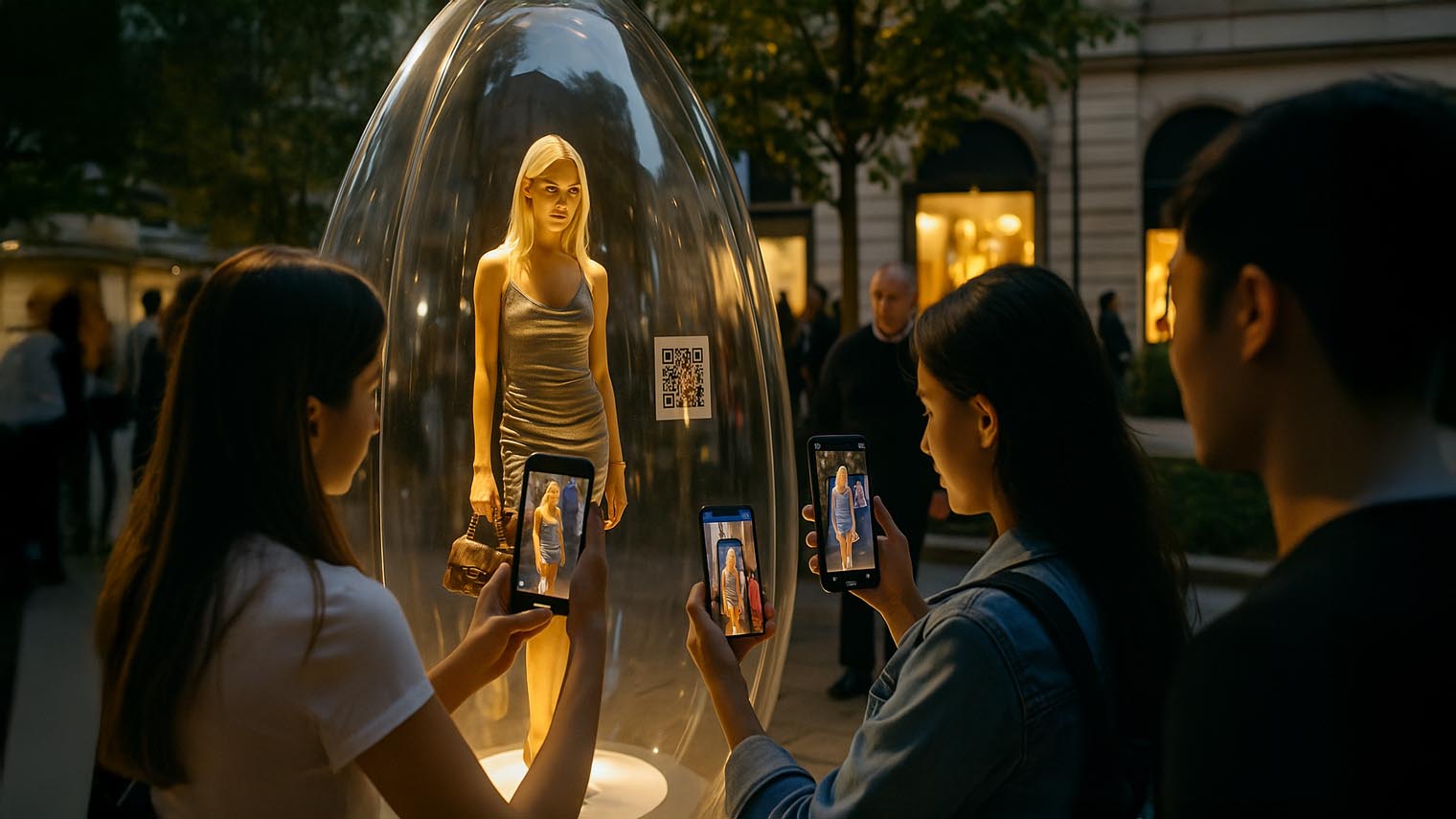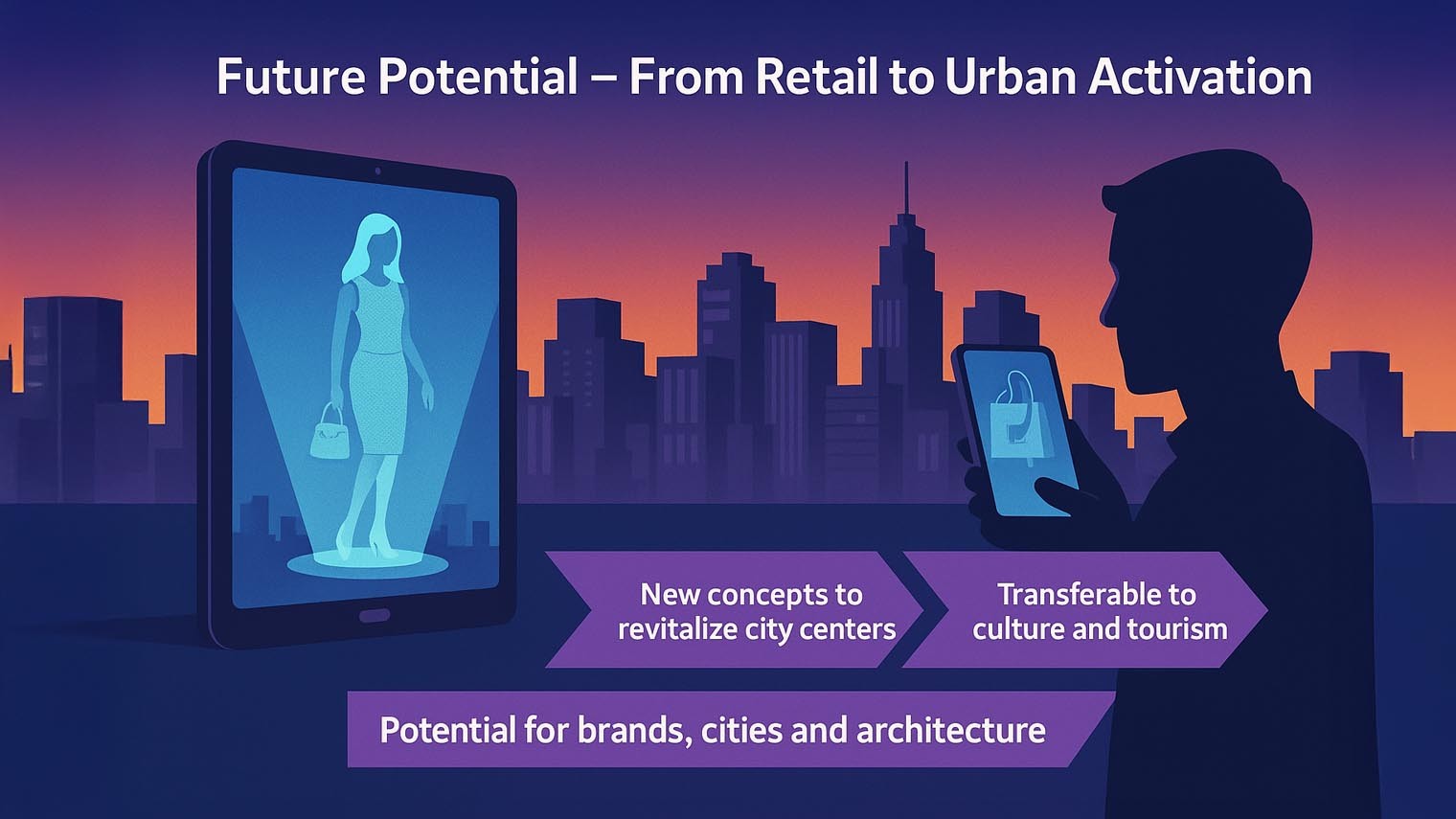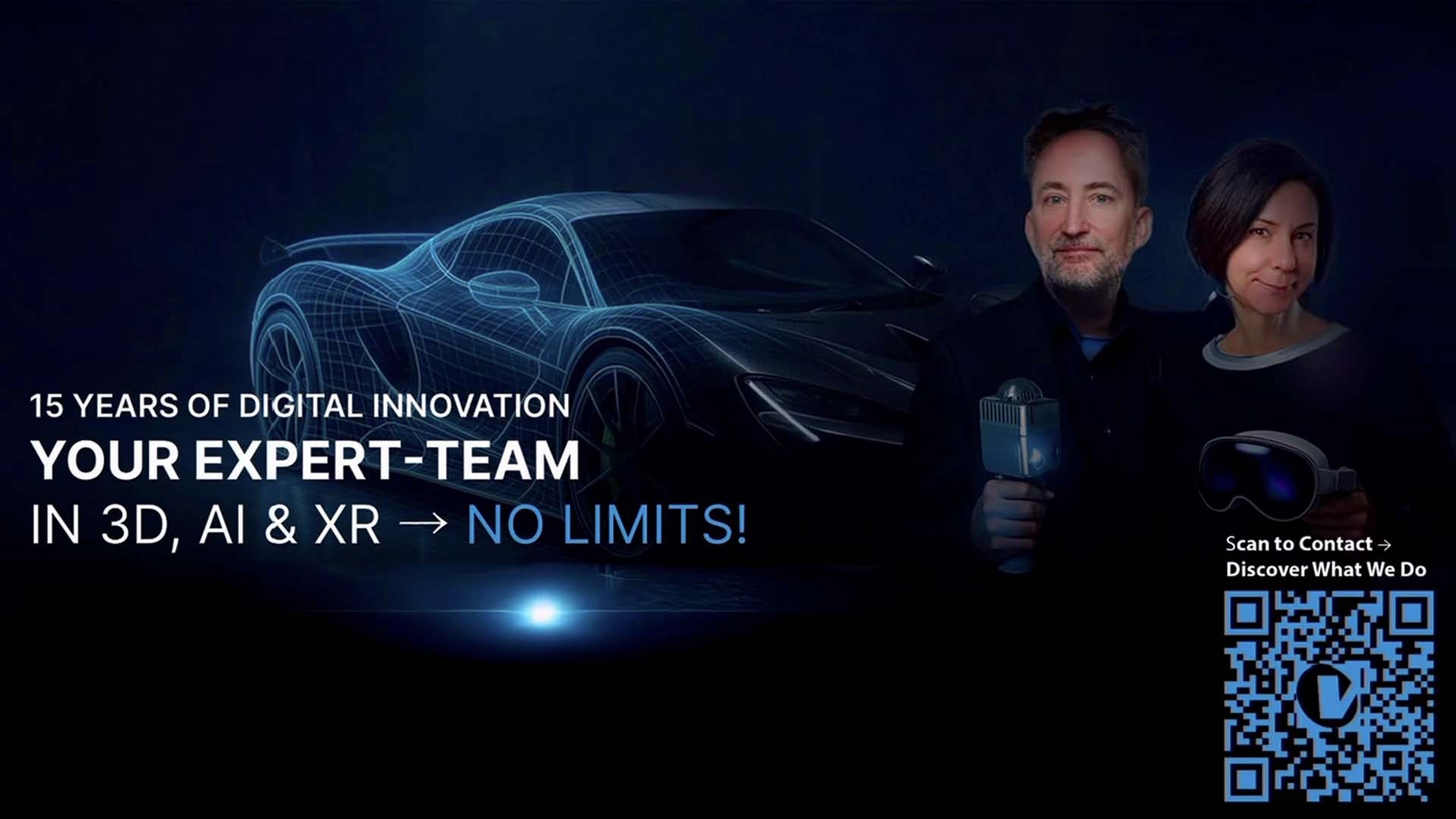Image: Fendi transforms Milan into an interactive AR experience | Source: hypebeaststyle / edited by Ulrich Buckenlei
When cities become a stage, the boundaries between culture, consumption, and technology blur. In Milan, Fendi demonstrated how Augmented Reality, holography, and artificial intelligence can transform urban spaces into interactive worlds of experience. Instead of classic window displays, holographic figures and digital installations took center stage – turning the streets themselves into a stage.
Urban Stage – The City as a Catwalk
The traditional fashion show left the catwalk and moved into the streets. Giant holographic eggs containing virtual figures turned the city into a playground for passersby. The installations were unlocked using QR codes, guiding visitors from one location to the next. Architecture became not just a backdrop, but an integral part of the production.
- Fashion storytelling merges with urban space
- Architecture becomes part of the stage
- Passersby experience the city as an interactive stage
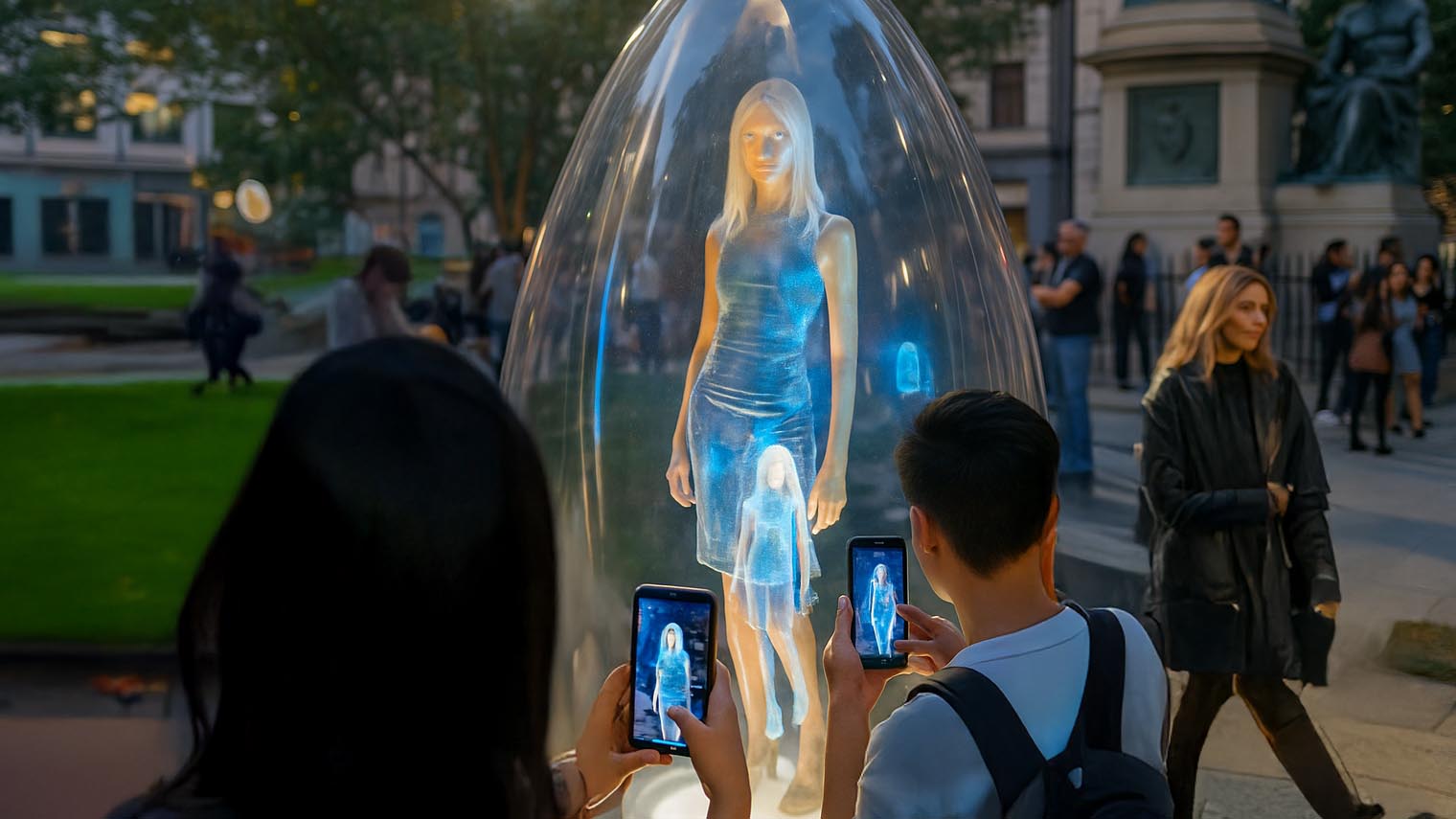
Image: Holographic fashion installation in urban space | Visualization: Ulrich Buckenlei Visoric GmbH 2025
This example shows how physical locations gain new meaning through digital layers. It also raises the question of how city centers can be revitalized through immersive formats. Public space becomes not just a place of transit but a place of experience – where brands, art, and technology come together naturally.
Behind this development lies the idea that the experiences of the future do not begin indoors but where people already are. With technologies like Gaussian Splatting and real-time 3D, these spaces can be temporarily expanded – precisely, data-driven, and aesthetically refined. The city thus becomes a stage for digital stories that directly impact everyday life.
Such projects require not only creative concepts but also the ability to merge 3D technology, sensor systems, and AR platforms into a stable whole. This is where teams like Visoric excel: they build bridges between design, technology, and space to ensure that immersive formats work in public contexts – safely, scalably, and emotionally engaging.
Immersive Tech – Interaction Instead of Display
AR and interactive scanning created a kind of “digital treasure hunt” in Milan. Those who discovered the QR codes on the streets experienced virtual extensions that brought fashion figures and scenes to life. The shopping experience turned into a citywide adventure where technology became the key to participation.
- AR scans create new ways of discovery
- Virtual layers expand physical space
- Technology becomes the ticket to the story
Image: Interactive AR hunt in the city | Visualization: Ulrich Buckenlei Visoric GmbH 2025
Immersion arises not from mere product presentation but from the combination of game mechanics, storytelling, and spatial staging.
Passersby become participants in an urban narrative where technology seduces rather than instructs. Each scan and each discovery triggers a small reward – a moment of curiosity that bridges the digital and physical worlds.
Through the use of Gaussian Splatting, these virtual layers can be precisely aligned with real-world locations. Light, perspective, and viewer movement are integrated into the rendering, making digital objects appear realistic and organically embedded in their surroundings. The difference to conventional AR applications lies in the depth – the projections don’t feel superimposed but rather part of the space itself.
For brands and cities, this opens up new forms of communication. The shop window becomes an interactive platform that conveys both information and emotion. Instead of static displays, dynamic environments emerge that evolve in real time. Visoric works on solutions that combine technological precision with creative freedom – turning moments into lasting experiences.
Audience Engagement – Participating Instead of Watching
A crucial difference lies in the role of the audience. Passersby became not only spectators but active participants in the production. By searching for installations and unlocking digital content, they became co-actors in an urban experience.
- Passersby become contributors
- Shopping experiences turn into city experiences
- Engagement replaces passive consumption
Image: AR interaction in open streets | Visualization: Ulrich Buckenlei Visoric GmbH 2025
This shows how immersive concepts not only strengthen brand loyalty but also create new forms of shared urban experiences.
When people discover digital experiences together, a moment of connection emerges – spontaneous, playful, and authentic. Technology fades into the background while the experience takes center stage.
The audience becomes part of a collective choreography formed in real time. Individual interactions influence the dynamics of the overall experience – a principle that is becoming increasingly relevant in industrial contexts as well. Whether in training, brand communication, or experiential architecture, the line between actor and observer is dissolving.
With methods such as Gaussian Splatting, these forms of participation can be planned and implemented with precision. The technology translates movement, position, and gaze direction directly into visible reactions in space. The result is an immersive interaction that is both emotionally compelling and data-driven – a fusion of creativity and technical accuracy.
Future Potential – From Retail to Urban Development
What began in Milan as a fashion installation extends far beyond retail. Immersive technologies can activate vacant urban spaces, enrich cultural content, and turn cities into interactive experience environments. Especially in times when physical retail is declining, AR and holography open new possibilities for bringing life back to city centers.
- New concepts for revitalizing urban centers
- Transferable to culture, tourism, and events
- Potential for brands, cities, and architecture
Image: Urban storytelling with AR and holography | Visualization: Ulrich Buckenlei Visoric GmbH 2025
The fusion of physical spaces with digital experiences is a growth field transforming entire industries beyond fashion.
AR-based formats make it possible to redefine places flexibly – through temporary installations, virtual exhibitions, or adaptive information environments. Hybrid environments emerge that generate economic, cultural, and social momentum simultaneously.
For cities, this offers the opportunity to creatively reactivate unused spaces and guide visitor flows strategically. Interactive experiences encourage people to linger and foster new forms of urban participation. Retailers, museums, or architectural firms can use the same technologies to increase visibility without permanently altering physical space.
In the long term, this principle will extend to areas such as education, mobility, and sustainability. Data-driven experiences can visualize environmental and energy processes, preserve cultural heritage, or convey learning content immersively. Teams like Visoric are working to translate these potentials into scalable applications – with a focus on utility, precision, and design quality.
Digital Experience Spaces in Public Areas
The video illustrates how immersive installations based on 3D scans and real-time data engage people in urban environments. The focus lies on connecting art, technology, and brand communication – accessible without a headset, directly in public space.
Insight: AR installations and real-time 3D visualizations in public space. Source: hyper
Source: Original activation by Fendi (Milan) · Video by hypebeaststyle / hypebeast · Text & Edit by Ulrich Buckenlei
The shown sequences illustrate how public places can be extended through digital layers. People intuitively move through the installations, discover content in their own way, and experience the city as a stage for interaction. The interplay of architecture, light, and digital objects creates an atmosphere that is both artistic and informative.
The true value of such projects lies in accessibility: no special device, ticket, or technical knowledge is required. The technology fades into the background, leaving space for the experience itself. This creates new forms of connection and participation – for brands, cities, or cultural initiatives aiming to merge public space with innovation.
Combining real-time 3D, AR tracking, and visual staging results in a communication space that goes far beyond traditional media formats. Visoric designs these spaces as modular systems adaptable to locations, topics, and audiences – from temporary urban experiences to long-term interactive installations.
From Vision to Implementation
Turning a creative idea into a functioning experience requires precise coordination of story, technology, and operations. This includes everything from the concept and design of interactive experiences to technical implementation and stable real-time operation. This is where crucial intersections between brand, space, and user experience emerge.
- Strategic concept development and storytelling
- Technical implementation using AR, 3D, and AI
- Integration into urban and commercial spaces
Digital experiences as an interface between space and technology
Visualization: Ulrich Buckenlei | Visoric GmbH 2025
From the first idea to a tangible experience, the process follows a clear structure: analysis, design, prototyping, and real-time integration. Each phase builds upon the previous one, creating a foundation for a stable, high-performance system. Visual quality convinces only when it’s technically precise – and vice versa. This interplay between design and engineering is the foundation of every successful project.
Especially with hybrid installations in public spaces, this process logic becomes essential. Factors such as light, weather, audience, and infrastructure must be considered from the start. The result is a digital experience that not only works but integrates naturally into its environment and remains operable in the long term.
VISORIC operates at this intersection between creative vision and technical reality. Projects are developed at the crossroads of design, software engineering, and real-time production. The goal is always the same: to create immersive experiences that intuitively engage people while showcasing the potential of modern 3D, AR, and AI technologies – in retail, industry, and public space.
Get in Touch
Would you like to develop immersive concepts for your company, brand, or city? Contact the Munich-based VISORIC team. Together, we develop digital experiences that combine technology, design, and storytelling – opening innovative solutions for retail, culture, and industry.
- Consulting and ideation workshops
- Technical implementation with AR, VR, and AI
- Integration and operation of real-time 3D experiences
Now is the right time to rethink urban spaces – we look forward to your ideas.
Contact Persons:
Ulrich Buckenlei (Creative Director)
Mobile: +49 152 53532871
Email: ulrich.buckenlei@visoric.com
Nataliya Daniltseva (Project Manager)
Mobile: +49 176 72805705
Email: nataliya.daniltseva@visoric.com
Address:
VISORIC GmbH
Bayerstraße 13
D-80335 Munich


